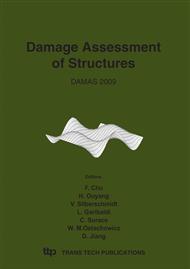[1]
W. Bartelmus, Mathematical modelling and computer simulations as an aid to gearbox diagnostics, Mechanical Systems and Signal Processing 15 (5) (2001), pp.855-871.
DOI: 10.1006/mssp.2001.1411
Google Scholar
[2]
I. Howard, S.X. Jia, J.D. Wang, The dynamic modelling of a spur gear in mesh including friction and a crack, Mechanical Systems and Signal Processing 15 (5) (2001), pp.831-853.
DOI: 10.1006/mssp.2001.1414
Google Scholar
[3]
A.K.S. Jardine, D.M. Lin, D. Banjevic, A review on machinery diagnostics and prognostics implementing condition-based maintenance, Mechanical Systems and Signal Processing 20 (7) (2006), pp.1483-1510.
DOI: 10.1016/j.ymssp.2005.09.012
Google Scholar
[4]
S.X. Jia, I. Howard, Comparison of localised spalling and crack damage from dynamic modelling of spur gear vibrations, Mechanical Systems and Signal Processing 20 (2) (2006), pp.332-349.
DOI: 10.1016/j.ymssp.2005.02.009
Google Scholar
[5]
H.N. Ozguven, D.R. Houser, Mathematical-Models Used in Gear Dynamics - A Review, Journal of Sound and Vibration 121 (3) (1988), pp.383-411.
DOI: 10.1016/s0022-460x(88)80365-1
Google Scholar
[6]
P.D. Samuel, D.J. Pines, A review of vibration-based techniques for helicopter transmission diagnostics, Journal of Sound and Vibration 282 (1-2) (2005), pp.475-508.
DOI: 10.1016/j.jsv.2004.02.058
Google Scholar
[7]
W. Staszewski, C. Boller, G.R. Tomlinson, Health Monitoring of Aerospace Structures: Smart Sensor Technologies and Signal Processing, John Wiley & Sons (2004).
DOI: 10.1002/0470092866
Google Scholar
[8]
X.H. Tian, M.J. Zuo and K.R. Fyfe, Analysis of the vibration response of a gearbox with gear tooth faults, Proceedings of IMECE04, 2004 ASME International Mechanical Engineering Congress and Exposition, November 13-20, 2004, Anaheim, CA, USA.
DOI: 10.1115/imece2004-59224
Google Scholar
[9]
D.C.H. Yang and J.Y. Lin, Hertzian damping, tooth friction and bending elasticity in gear impact dynamics, Journal of Mechanisms, Transmissions, and Automation in Design 109 (2) (1987), pp.189-196.
DOI: 10.1115/1.3267437
Google Scholar
[10]
P. Velex, M. Ajmi, Dynamic tooth loads and quasi-static transmission errors in helical gearsapproximate dynamic factor formulae, Mechanism and Machine Theory 42 (2007), pp.1512-1526.
DOI: 10.1016/j.mechmachtheory.2006.12.009
Google Scholar
[11]
S. Wu, M.J. Zuo, and A. Parey, Simulation of spur gear dynamics and estimation of fault growth, Journal of Sound and Vibration (2008), doi: 10. 1016/j. jsv. 2008. 03. 038.
DOI: 10.1016/j.jsv.2008.03.038
Google Scholar


